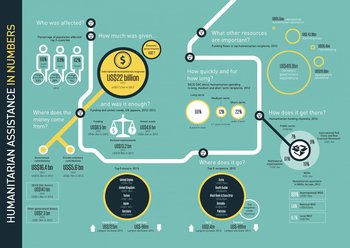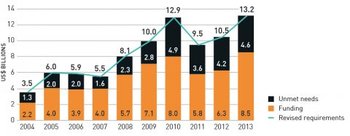There is no let-up in the need for humanitarian assistance. Now more than ever. The Ebola outbreak, Ukraine, Iraq and Gaza have in the last few months added to an already weighty list of demands for funds and placed even more pressure on already stretched donors and delivery agencies. Resources were already challenged to respond to the four ‘Level 3’ crises in South Sudan, Syria, the Philippines and the Central African Republic – let alone new and ongoing needs elsewhere. It’s a far cry from 2012 – described as ‘the year of no mega-disasters’.
So what can we learn from recent trends in humanitarian assistance to inform the difficult daily decisions that donors and delivery agencies are currently facing? What was the financial response to the challenges of 2013’s crises? Did the budgets match the needs? In the Global Humanitarian Assistance Report 2014, released today, we’ve brought together the latest available data to shed light on these questions. Here are just a few of our key findings:
How much money was there?
The scale of the funding rose in the face of 2013’s crises – to a record US $22 billion. This was a sharp turn-around from the decreases of the previous two years. So, at least at a global level, it wasn’t a question of humanitarians having to do more with less – more of having to do more with still-not-enough. UN-coordinated appeals alone were 65% funded – leaving over a third of needs unmet.
Where did it come from?
Government donors provided three quarters of this record sum – at US $16.4 billion this was a rise of 24% from the previous year. And funding from government donors both inside and outside the OECD’s Development Assistance Committee (DAC) rose, with both groups reporting their highest levels to date.
Quite a change from the previous year, when a fall from DAC donors was cushioned by an increase from others.
Funding from DAC donors increased by 20%, and that from ‘non-DAC’ donors by 58% – largely driven by the response to the Syria crisis.
Private donors – that’s individuals, trusts and foundations and corporations – remain important. They gave over a quarter of international humanitarian assistance in the past 5 years and their contribution rose by 35% in 2013.
Where did it go?
The Syria appeals received over 37% of all funding to UN-coordinated appeals in 2013. Even before the 2013 escalation in the crisis, in 2012 (the latest year for which comprehensive recipient data is available) Syria received by far the largest volume of humanitarian assistance. At US $1.5 billion it was almost double the amount that went to South Sudan, the next largest recipient.
It’s clear that the benefits of the global rise in humanitarian assistance were not evenly spread. Afghanistan, Somalia, Sudan, Ethiopia and the West Bank and Gaza strip consistently appeared in the list of top 10 recipients over a five year period – others, including Myanmar and Algeria, were repeatedly forgotten emergencies.
How long for?
Although commonly perceived as rapid emergency response, two thirds of humanitarian spending from DAC donors in fact went to long-term recipient countries, according to the latest data – supporting the need for flexible and multi-year funding.
It’s worth bearing in mind too, that at the latest count, humanitarian assistance made up 3% of international resource flows in the top 20 recipient countries – in contrast, remittances made up 21% and development assistance 14%. It clearly takes much more than humanitarian assistance to begin to address the vulnerabilities that push people into crisis and keep them there – and to allow those stretched humanitarian resources to better meet the most extreme needs.
You’ll find more data and analysis on all of these issues and many more in the report. Do contact us with your questions and comments, and join the discussion at #2014GHA and follow us @gha_org.


